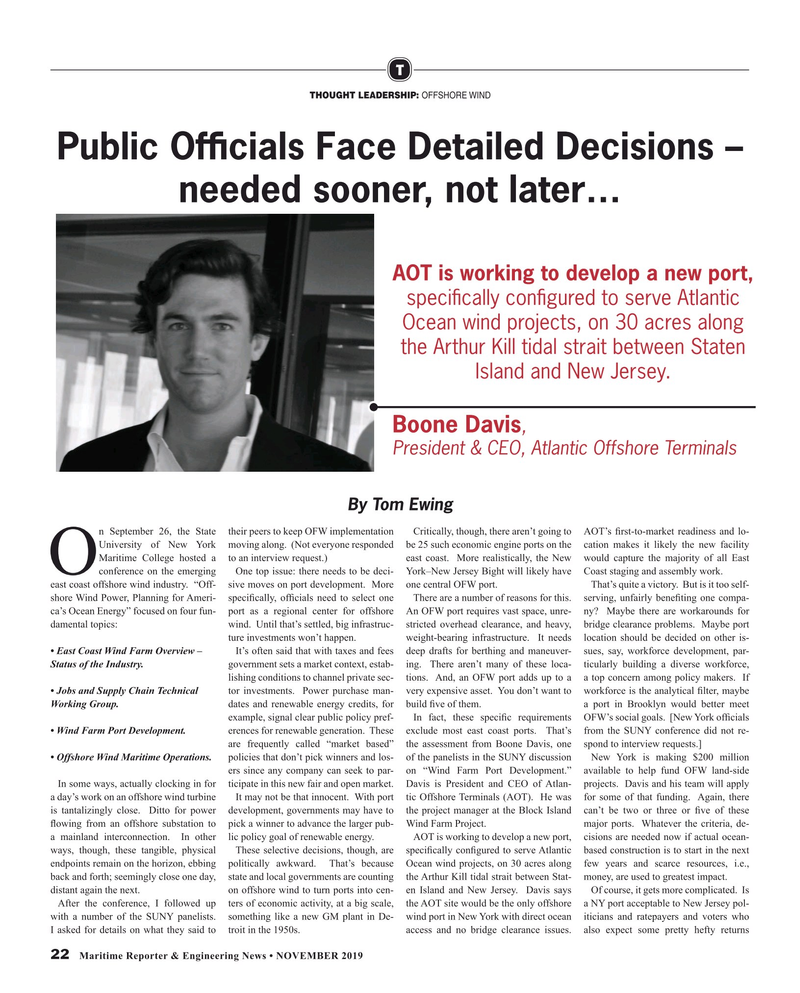
Page 22: of Maritime Reporter Magazine (November 2019)
Workboat Edition
Read this page in Pdf, Flash or Html5 edition of November 2019 Maritime Reporter Magazine
T
THOUGHT LEADERSHIP: OFFSHORE WIND
Public Of? cials Face Detailed Decisions – needed sooner, not later…
AOT is working to develop a new port, speci? cally con? gured to serve Atlantic
Ocean wind projects, on 30 acres along the Arthur Kill tidal strait between Staten
Island and New Jersey.
Boone Davis,
President & CEO, Atlantic Offshore Terminals
By Tom Ewing n September 26, the State their peers to keep OFW implementation Critically, though, there aren’t going to AOT’s ? rst-to-market readiness and lo-
University of New York moving along. (Not everyone responded be 25 such economic engine ports on the cation makes it likely the new facility
Maritime College hosted a to an interview request.) east coast. More realistically, the New would capture the majority of all East
Oconference on the emerging One top issue: there needs to be deci- York–New Jersey Bight will likely have Coast staging and assembly work. east coast offshore wind industry. “Off- sive moves on port development. More one central OFW port. That’s quite a victory. But is it too self- shore Wind Power, Planning for Ameri- speci? cally, of? cials need to select one There are a number of reasons for this. serving, unfairly bene? ting one compa- ca’s Ocean Energy” focused on four fun- port as a regional center for offshore An OFW port requires vast space, unre- ny? Maybe there are workarounds for damental topics: wind. Until that’s settled, big infrastruc- stricted overhead clearance, and heavy, bridge clearance problems. Maybe port ture investments won’t happen. weight-bearing infrastructure. It needs location should be decided on other is- • East Coast Wind Farm Overview – It’s often said that with taxes and fees deep drafts for berthing and maneuver- sues, say, workforce development, par-
Status of the Industry. government sets a market context, estab- ing. There aren’t many of these loca- ticularly building a diverse workforce, lishing conditions to channel private sec- tions. And, an OFW port adds up to a a top concern among policy makers. If • Jobs and Supply Chain Technical tor investments. Power purchase man- very expensive asset. You don’t want to workforce is the analytical ? lter, maybe
Working Group. dates and renewable energy credits, for build ? ve of them. a port in Brooklyn would better meet example, signal clear public policy pref- In fact, these speci? c requirements OFW’s social goals. [New York of? cials • Wind Farm Port Development. erences for renewable generation. These exclude most east coast ports. That’s from the SUNY conference did not re- are frequently called “market based” the assessment from Boone Davis, one spond to interview requests.] • Offshore Wind Maritime Operations. policies that don’t pick winners and los- of the panelists in the SUNY discussion New York is making $200 million ers since any company can seek to par- on “Wind Farm Port Development.” available to help fund OFW land-side
In some ways, actually clocking in for ticipate in this new fair and open market. Davis is President and CEO of Atlan- projects. Davis and his team will apply a day’s work on an offshore wind turbine It may not be that innocent. With port tic Offshore Terminals (AOT). He was for some of that funding. Again, there is tantalizingly close. Ditto for power development, governments may have to the project manager at the Block Island can’t be two or three or ? ve of these ? owing from an offshore substation to pick a winner to advance the larger pub- Wind Farm Project. major ports. Whatever the criteria, de- a mainland interconnection. In other lic policy goal of renewable energy. AOT is working to develop a new port, cisions are needed now if actual ocean- ways, though, these tangible, physical These selective decisions, though, are speci? cally con? gured to serve Atlantic based construction is to start in the next endpoints remain on the horizon, ebbing politically awkward. That’s because Ocean wind projects, on 30 acres along few years and scarce resources, i.e., back and forth; seemingly close one day, state and local governments are counting the Arthur Kill tidal strait between Stat- money, are used to greatest impact.
distant again the next. on offshore wind to turn ports into cen- en Island and New Jersey. Davis says Of course, it gets more complicated. Is
After the conference, I followed up ters of economic activity, at a big scale, the AOT site would be the only offshore a NY port acceptable to New Jersey pol- with a number of the SUNY panelists. something like a new GM plant in De- wind port in New York with direct ocean iticians and ratepayers and voters who
I asked for details on what they said to troit in the 1950s. access and no bridge clearance issues. also expect some pretty hefty returns 22 Maritime Reporter & Engineering News • NOVEMBER 2019
MR #11 (18-25).indd 22 10/29/2019 10:06:21 AM

 21
21

 23
23
